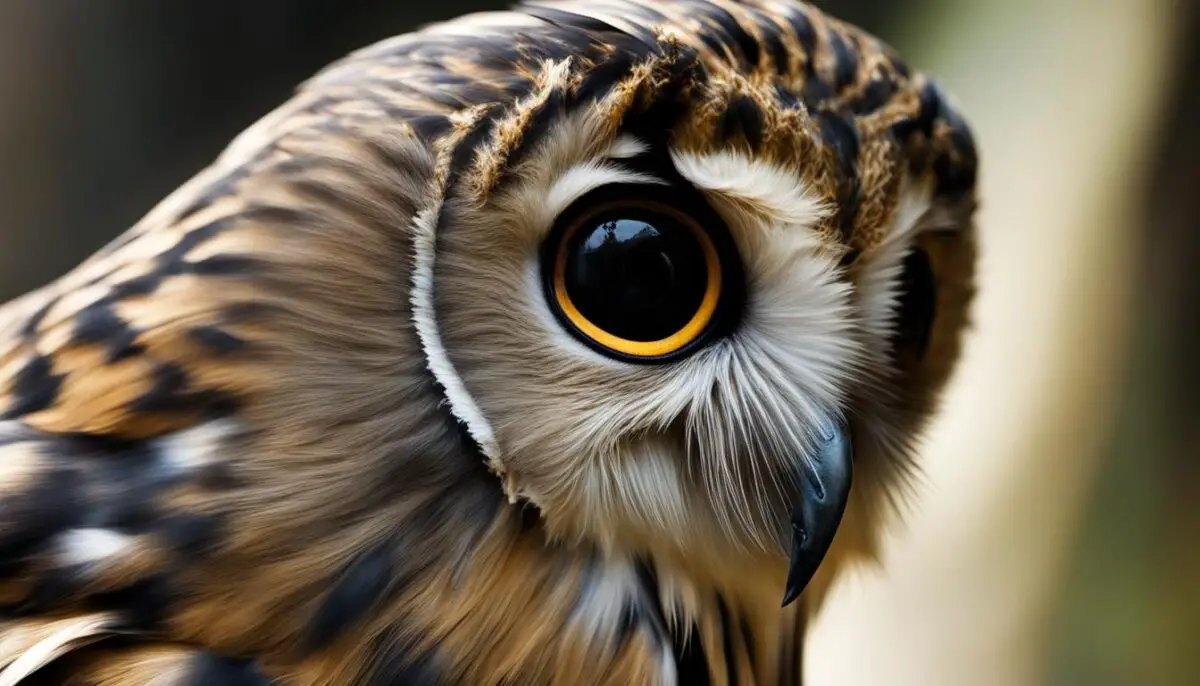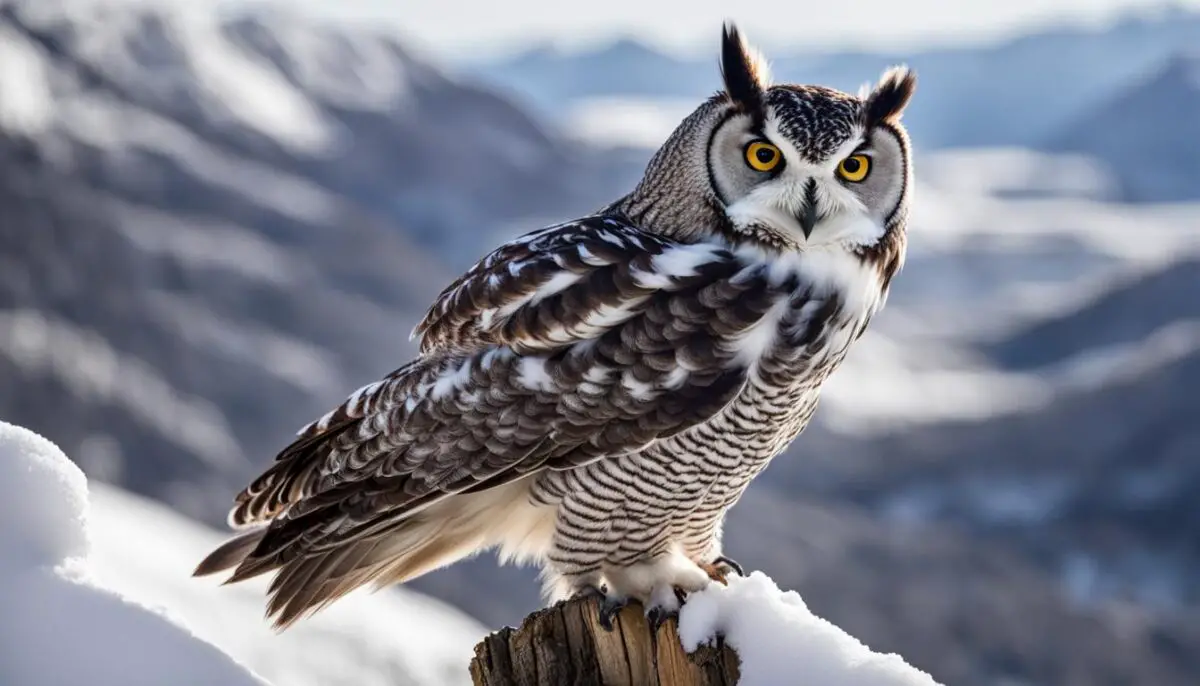Owls are fascinating creatures that are known for their unique characteristics, such as their ability to fly silently and turn their heads nearly 360 degrees. But did you know that owls also have long legs? It’s a surprising truth that many people are unaware of.
When we think of owls, we often envision them perched on a branch, with their body feathers concealing their legs. However, beneath those feathers lie legs that are longer than they appear. The anatomy of owl legs includes a long, slender bone called the tarsometatarsus, which gives them their extended length.
So why do owls have long legs? Let’s delve deeper into the characteristics and functions of their leg structure to uncover the secrets behind this intriguing adaptation.
Key Takeaways:
- Owls have longer legs than they appear, hidden by their feathers.
- The anatomy of owl legs includes a long, slender bone called the tarsometatarsus.
- Owl legs allow for better attack angles when hunting and keep their sensitive organs, like their eyes, at a safe distance.
- Owl legs play a crucial role in flight, weight distribution, and balance.
- The leg structure of some owl species helps them survive in cold environments.
Why Do Owls Have Long Legs?
Owls are fascinating creatures with a variety of unique adaptations. One such adaptation is their long legs, which serve multiple important purposes. Let’s explore why owls have evolved these distinctive leg characteristics.
A Perfect Fit for Flight
The long legs of owls are primarily adaptations for flight. Their slim and delicate structure helps with weight distribution and balance while soaring through the air. By having longer legs, owls can adjust their body position and maneuver more effectively in the sky, enhancing their agility and hunting efficiency.
A Key Role in Hunting
Owl legs play a crucial role in their hunting strategy. These magnificent birds use their long legs and sharp talons to catch and kill their prey. The slimness of their legs allows them to maintain a streamlined shape while swooping down from above to seize their unsuspecting prey with precision. The thin legs conceal surprising strength, enabling owls to carry prey that weighs multiple times their own body weight.
“The long legs of owls serve as powerful tools, enabling them to snatch prey and deliver devastating blows with their talons.”
Surviving in Chilly Environments
For some owl species, their leg structure also helps them thrive in cold environments. The main muscles of their legs are positioned close to the body, providing insulation and keeping the muscles warm. In addition, the legs are made up of bone and tendon, which are less susceptible to freezing temperatures. These adaptations enable owls to navigate and hunt comfortably even in frigid conditions.
To better understand the unique leg structure of owls, take a look at the diagram below:

As shown in the image, the joint that appears to be the knee is located higher up, forming the anklet, and the foot bone elongates to create the leg. These adaptations contribute to the illusion of long legs in owls, captivating observers with their intriguing leg anatomy.
Owl Leg Anatomy Comparison
Comparing the anatomy of owl legs to human legs highlights the unique characteristics of owl leg appearance:
| Owl Legs | Human Legs |
|---|---|
| Higher-placed ankles | Ankles positioned lower |
| Shorter thighs | Longer thighs |
| Toes as main support | Feet flat on the ground |
This table showcases the key contrasts between owl leg anatomy and human leg anatomy, emphasizing the unique features of owl legs and their contribution to the illusion of length.
Now that we have explored the distinctive anatomy and appearance of owl legs, let’s delve into how these unique leg characteristics play a vital role in owls’ flight, hunting, and survival strategies.
Owls and Their Leg Adaptations for Hunting
Owls are skilled predators that have evolved unique leg adaptations for their hunting strategies. Their long legs play a crucial role in capturing prey and ensuring their own safety during the hunt. Let’s explore how owl leg adaptations contribute to their hunting success.
One of the key advantages of owl legs is their length, which allows owls to land feet-first and deliver a fatal blow to their prey using their sharp talons. These talons are exceptionally strong, allowing owls to constrict or stab their prey to death. While their beak serves as a secondary tool, the primary method of prey capture is through the use of their talons.
“By using their talons to subdue prey, owls can keep their heads and eyes safely out of harm’s way.”
The strength of owl legs and talons enables them to carry off prey, even if it weighs multiple times their own body weight. This ability to deliver powerful kicks and carry prey demonstrates the impressive muscular strength of owl legs.
To further illustrate the importance of owl leg adaptations for hunting, let’s take a closer look at some specific species:
| Owl Species | Hunting Strategy |
|---|---|
| Barn Owl | Uses its powerful talons to swoop down on small mammals and birds. |
| Snowy Owl | Hunts primarily during the day, using its long legs to chase down prey on the ground. |
| Great Horned Owl | Uses its strong legs and talons to capture a wide range of prey, including mammals, birds, and reptiles. |
“The unique leg adaptations of owls enable them to excel in their hunting endeavors.”
Overall, owl leg adaptations play a vital role in their hunting strategies. The combination of long legs and powerful talons allows them to effectively subdue and carry off their prey. These adaptations not only enhance their hunting efficiency but also ensure their own safety during the capture process.

With these adaptations, owls can tolerate colder temperatures without compromising their locomotive abilities. Their legs remain fully functional and capable of supporting their body weight, even in frigid conditions.
The ability of owl legs to withstand the cold and maintain optimal performance showcases the remarkable adaptations that these birds have developed over time. It allows them to inhabit a wide range of climates and successfully navigate the challenges of colder environments.
Can Owls Run with Their Long Legs?
While owls are capable of running, their primary mode of movement is perching and flying. Most owl species prefer to utilize their strong legs for these activities rather than running. However, there is an exception – the burrowing owl. This species can often be observed running on the ground to catch its prey.
Owls possess excellent balance, thanks to their unique foot structure. They have one talon that faces backward and three talons that face forward. This arrangement allows them to grip branches and other surfaces securely, ensuring stability while perching. Additionally, owls can stand on one foot for extended periods, switching legs to avoid strain.
While running is not a common sight for most owl species, their leg structure and coordination contribute to their overall agility and adaptation to various environments.
Foot Structure of Owls
The foot structure of owls is unlike that of many other animals. Their feet have one toe that can rotate backward, giving them the ability to grasp and carry prey securely. The three forward-facing toes have sharp, curved claws called talons, which they use for hunting and subduing their prey.
“Owls have a foot structure that enables them to be highly effective hunters. Their unique adaptations and coordination of their legs provide them with remarkable agility and balance.”
Running vs. Flying
Running is not the most efficient mode of movement for owls. Their strong wings and ability to fly allow them to navigate their surroundings more effectively. Owls rely on their wings to cover large distances quickly and effortlessly. However, their running capabilities, when required, demonstrate the versatility and adaptability of these remarkable birds.
To get a better understanding of the difference between running and flying for owls, let’s compare their movements in a table:
| Movement Type | Advantages | Disadvantages |
|---|---|---|
| Running | Useful for catching prey on the ground | Less efficient compared to flying |
| Flying | Enables rapid and long-distance travel | Requires more energy |
In conclusion, while owls can run, it is not their preferred mode of movement. Their long legs serve them better in perching, flying, and hunting. However, the burrowing owl demonstrates the exception to this pattern, showcasing its ability to run on the ground as it pursues its prey.
Conclusion
Owls, with their long legs, possess remarkable adaptations for various aspects of their lives. From flight and hunting to perching and braving cold climates, these unique leg characteristics contribute to their incredible agility and survival. While not all owls have long legs, many species boast this fascinating attribute, adding to the allure and mystery surrounding these captivating creatures.
The hidden nature of owl legs, often concealed by feathers, adds an element of intrigue, making them even more intriguing to study and appreciate. Their leg structure allows them to soar through the air with grace, capturing and subduing prey with their powerful talons. These long legs also play a crucial role in perching on branches for extended periods, even in chilly environments.
Overall, the long-legged owls exemplify nature’s ingenuity. Their leg adaptations showcase the immense diversity and exceptional features of these magnificent birds. Whether it’s their flight, hunting strategy, or ability to thrive in different climates, owl leg characteristics leave a lasting impression, underscoring the remarkable nature of these avian wonders.
FAQ
Do owls really have long legs?
Yes, owls have longer legs than they appear, hidden by their feathers.
Why do owls have long legs?
Owl legs are adaptations for flight, weight distribution, balance, and hunting.
How do owl legs function in flight?
The slim and delicate legs of owls help with weight distribution and balance while flying, allowing them to soar gracefully through the air.
What is unique about owl leg anatomy?
Owl legs have a long, slender bone called the tarsometatarsus, and their joint that appears to be the knee is actually the ankle. These characteristics give owls the illusion of long legs.
How do owls use their legs for hunting?
Owls use their sharp talons to catch and subdue prey, delivering a fatal blow with their feet to keep their heads and eyes safe.
How do owl legs adapt to cold environments?
Some owl species, such as the Great Gray Owl and the Snowy Owl, have leg structures that help them survive in low temperatures. Their legs are made mostly of bone and tendon, allowing them to tolerate the cold without losing function or getting frostbite.
Can owls run with their long legs?
While most owls prefer to use their strong legs for perching and flying, the burrowing owl is an exception and can often be seen running on the ground to catch prey.
Do all owl species have long legs?
Not all owl species have long legs, but many showcase this unique characteristic.
Do owl legs have any other functions?
Owl legs also aid in perching on trees for extended periods and contribute to their distinctive appearance and mystery.

